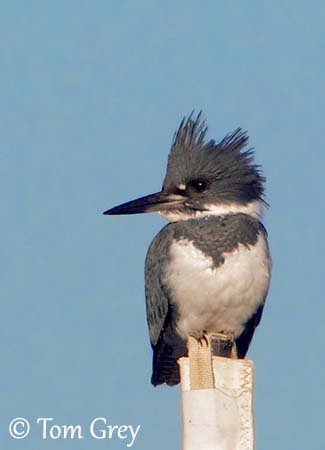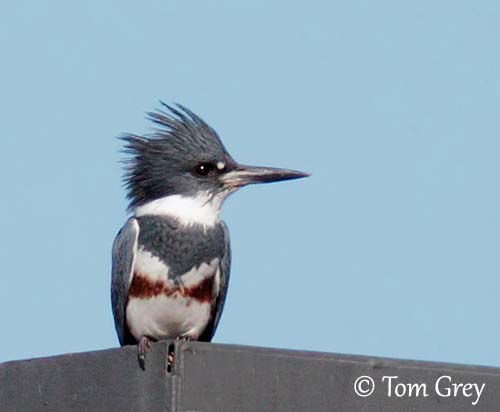
Fr: Martin-pêcheur d’Amérique
All : Gürtelfischer
Esp : Martín Gigante Norteamericano
Ita : Martin pescatore americano
Nd : Bandijsvogel
Sd : Bälteskungsfiskare
Photographer:
Tom Grey
Tom Grey's Bird Pictures
Text by Nicole Bouglouan
Sources:
HANDBOOK OF THE BIRDS OF THE WORLD Vol 6 by Josep del Hoyo-Andrew Elliott-Jordi Sargatal - Lynx Edicions, 2001 - ISBN: 848733430X
A GUIDE TO THE BIRDS OF MEXICO AND NORTHERN CENTRAL AMERICA by Steve N. G. Howell, Sophie Webb - Oxford University Press - ISBN: 0198540124
A GUIDE TO THE BIRDS OF COLOMBIA by Steven L. Hilty and William L. Brown - Princeton University Press – ISBN 069108372X
BirdLife International (BirdLife International)
Animal Diversity Web (University of Michigan Museum of Zoology)
All About Birds (Cornell Lab of Ornithology)
What Bird-The ultimate Bird Guide (Mitchell Waite)
Belted Kingfisher
Megaceryle alcyon
Coraciiformes Order – Alcedinidae Family
INTRODUCTION:
The Belted Kingfisher is a solitary bird except when breeding. This large kingfisher is often found perched along rivers, lakes, ponds and marshes, watching for preys. It strongly defends its feeding areas against other kingfishers. It may perform spectacular dives from the air when a prey is detected. Unlike numerous bird species, the female is more colourful than the male!

DESCRIPTION OF THE BIRD:
Biometrics:
Length: 28-33 cm
Weight: M: 113-173 g – F: 138-178 g
The adult male has blue-grey head and upperparts, including wings and scapulars. We can see a white spotting on wings and tail, the latter showing numerous dark and light narrow bands. There is a white wing patch on the flight feathers.
The underparts are white, with conspicuous blue-grey breast band. The flanks are white washed blue-grey. The underwing-coverts are white. The white wing patch is well visible in flight.
The head is blue-grey, with conspicuous shaggy pointed crest. There is a white spot above the lore. Chin, throat and neck are white.
The long, stocky bill is blackish. The eyes are dark brown. Short legs and feet are pinkish-grey.
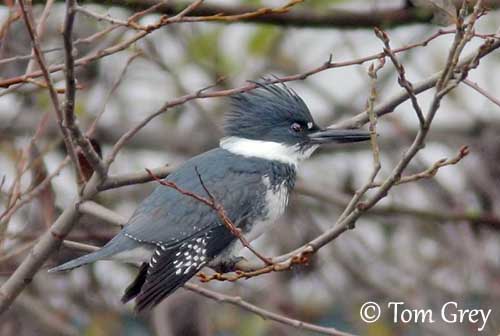
The female is similar but she has an additional rusty breast band below the blue-grey band. The flanks are rufous.
The juvenile resembles female. The young male shows rufous wash to the grey breast band, which is more conspicuous in young female.
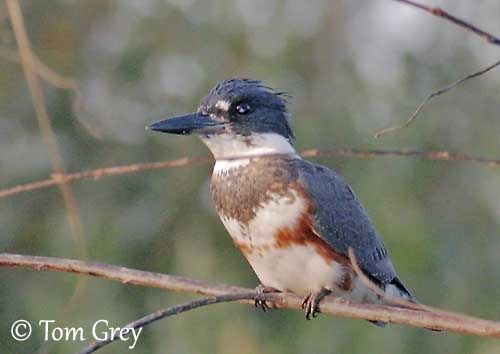
RANGE:
The Belted Kingfisher breeds across most of Canada, Alaska and United States (S California, S Texas and N Coast of Gulf of Mexico).
It migrates S to its winter range, to E Panama, N Colombia, Venezuela, Guyana, Galapagos Islands and the Caribbean to Trinidad.
HABITAT:
The Belted Kingfisher frequents the shores of rivers, mountain streams, lakes, ponds, marshes and tidal creeks with suitable elevated perches from where it watches for fish. However, it may sometimes forage offshore.
The breeding habitat requires suitable nest-sites such as vertical banks near water, but also ditches, road-cutting, gravel pit, roots of fallen trees, sometimes far from water.
During winter, it uses similar habitat types, but it is less usually found near lakes and large rivers. It may be found in mangroves and even on offshore islands. This species occurs from sea-level up to 2500 metres of elevation.
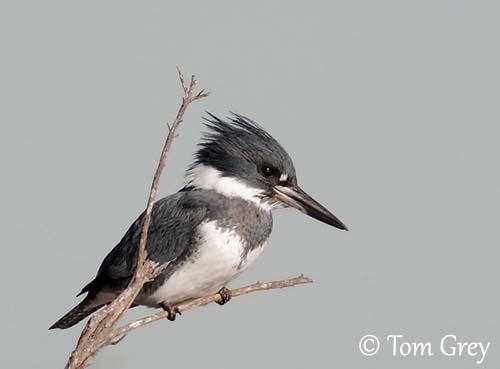
CALLS AND SONGS: SOUNDS BY XENO-CANTO
The Belted Kingfisher is usually heard before to be seen. It gives a loud, rattling call of variable length “kekity-kek-kek-kek-ticky-kek”. This call can be heard during the territorial squabbles or against human intruders. It may utter at least six different calls used in different situations, but this high-pitched rattling call is the most commonly heard.
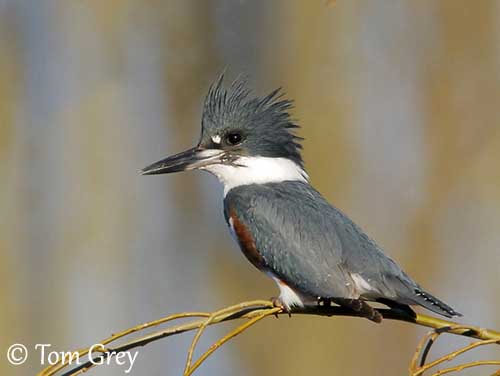
BEHAVIOUR IN THE WILD:
The Belted Kingfisher feeds mainly on fish of 9-14 cm long. But it also takes molluscs, amphibians, crustaceans, lizards and even nestling birds such as sparrow and quails. Small rodents can be caught sometimes, like various insects. It feeds on berries during winter.
It forages by hovering over the surface. When the prey is detected (less than 60 cm below the surface), the Belted Kingfisher dives vertically but does not submerge. It grabs the fish with the bill in a pincer-like action. Then, it flies back to its perch where the fish is beaten before to be swallowed whole and head first.
Other preys such as insects, lizards, young birds and rodents are taken by swooping down to catch them from a perch.
Later, it will regurgitate pellets with bones and other indigestible items.
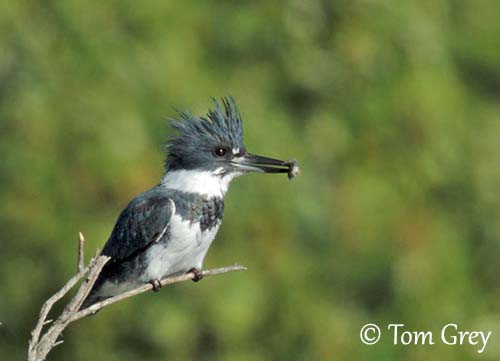
During the breeding season, some displays are observed. The male establishes the territory and the female visits it. They perform chasing flights accompanied by loud calls. The male gives food to the female as courtship, and prior to copulation. Aerial displays are performed by the pair high in the air, and later, the male continues alone while the female remains perched. It performs a spiral ascent ending in somersaulting descent before to rise by gliding with extended wings.
They are seasonally monogamous. The pair defends strongly the territory against other kingfishers. They nest in underground burrows near water.
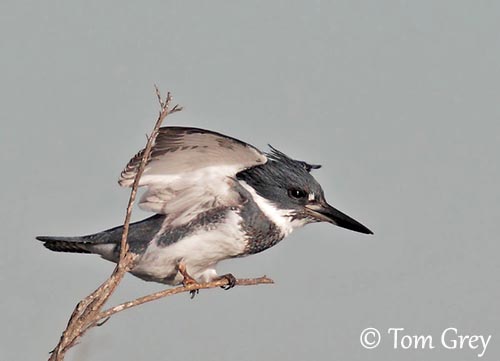
The Belted Kingfisher is partially migratory (see range) with birds moving S in winter. Some birds may winter throughout the breeding range, and especially the males. Some nocturnal migration may occur. The juveniles disperse locally and usually return to their hatching areas.
The Belted Kingfisher has an agile flight when hunting and during the aerial displays. Over longer distances, the wingbeats can appear uncoordinated and uneven at times, and the flight is unsteady.
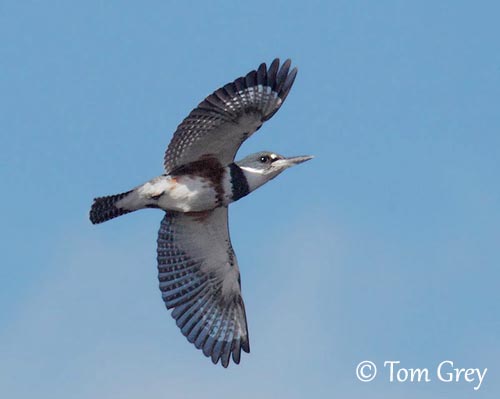
REPRODUCTION OF THIS SPECIES:
The breeding season varies depending on the range.
Both mates work together and dig the tunnel. This work may last a few days in sandy soil and up to three weeks in harder ground. The tunnel is 1-2 metres long, sometimes more, with a diameter of 9-10 cm. it is slightly inclined and the nest-chamber is at the end. This is an area of about 20-30 cm in diameter and 15-18 cm high. The floor is bare, but a layer of pellets accumulates through the cycle.
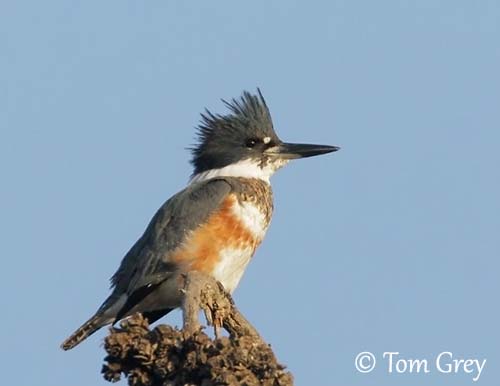
The female lays 6-7 white eggs. Both adults incubate during 22-24 days. At hatching, the chicks are naked and have pink skin and black bill. They are brooded during the first 5-6 days. They are fed by both adults by regurgitation of semi-digested fish. They fledge about 27-35 days after hatching, but they still depend on parents for food for three weeks more.
They perch in the vicinity of the nest because they have weak flight.
PROTECTION / THREATS / STATUS:
The Belted Kingfisher is widespread and can be locally common. It is vulnerable to human disturbance when breeding. But in spite of small annual decline, the population remains stable.
This species is not currently threatened.
